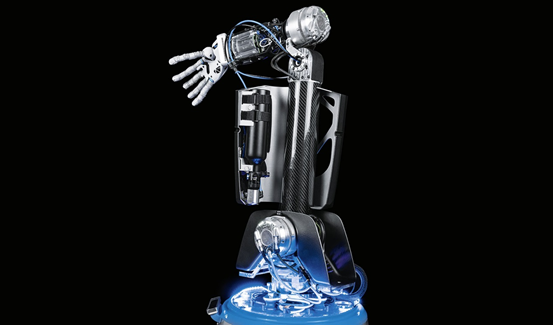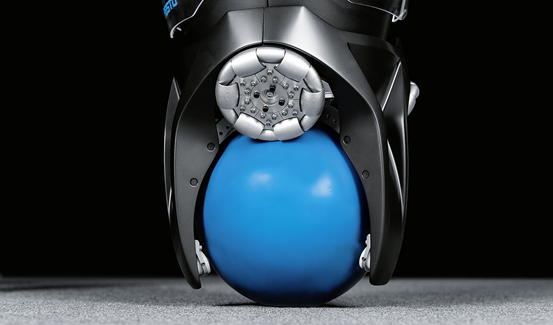The BionicMobileAssistant moves autonomously in space and can independently recognise objects, grasp them adaptively and work on them together with humans. The processing of the acquired information is performed by a neural network that has been trained in advance using data augmentation.
Modular assistance system
In cooperation with ETH Zurich, the BionicMobileAssistant was developed, which consists of three subsystems: a mobile robot, an electric robot arm and the BionicSoftHand 2.0. The pneumatic gripper is inspired by the human hand and is a further development of the BionicSoftHand from 2019.
Finely tuned gripper with fingertip sensitivity
The hand wears a glove with tactile force sensors on the fingertips, the palm and the outside of the robot hand. This allows them to feel how hard the object to be gripped is and how well it fits in the hand, and adapt their gripping force to the object in question – just like we humans do. In addition, a depth camera is located on the inside of the wrist for visual object detection.

Object detection by means of a neural network
With the help of the camera images, the robot hand can recognize and grip various objects, even if they are partially covered. After appropriate training, the hand can also assess the objects on the basis of the recorded data and thus distinguish good from bad, for example. The information is processed by the neural network, which was trained in advance using data augmentation.
Extensive data sets through data augmentation
In order to achieve the best possible results, the neural network needs a lot of information with which it can orient itself. This means the more training images are available to it, the more reliable it becomes. Since this is usually time-consuming, automatic augmentation of the database is a good idea.
This procedure is called data augmentation. By marginally modifying a few source images – for example, with different backgrounds, lighting conditions or viewing angles – and duplicating them, the system obtains a comprehensive data set with which it can work independently.
Mobile use at changing locations
The system has its entire power supply on board: the battery for the arm and robot sits inside the body. The compressed air cartridge for the pneumatic hand is installed in the upper arm. This means that the robot is not only mobile, it can also move autonomously.
The algorithms stored on the master computer also control the autonomous movements of the system. With a view to the future, they plan how the arm and the ball must move in order to reach certain target points while maintaining balance. With the help of two cameras, the robot orients itself independently in space: one camera searches for predefined fixed points in the environment to position itself autonomously, while a second camera uses the ceiling structure to estimate movement.
Its mobility and autonomous energy supply enable the BionicMobileAssistant to be used flexibly for different tasks at changing locations – in line with the constantly changing production environment.

Versatile application possibilities
The system would be predestined for use as a direct assistant to humans, for example as a service robot, as a helping hand in assembly or to support workers in ergonomically stressful or monotonous work. It could also be used in environments where people cannot work, for example due to hazards or limited accessibility.
Hand in hand with humans
Thanks to its modular concept, the BionicSoftHand 2.0 can also be quickly mounted and commissioned on other robot arms. Combined with the BionicCobot or the BionicSoftArm, the gripper forms, for example, a completely pneumatic robot system that can work hand in hand with humans due to its inherent flexibility.
Information Source: https://www.festo.com.cn/group/zh/cms/13767.htm

